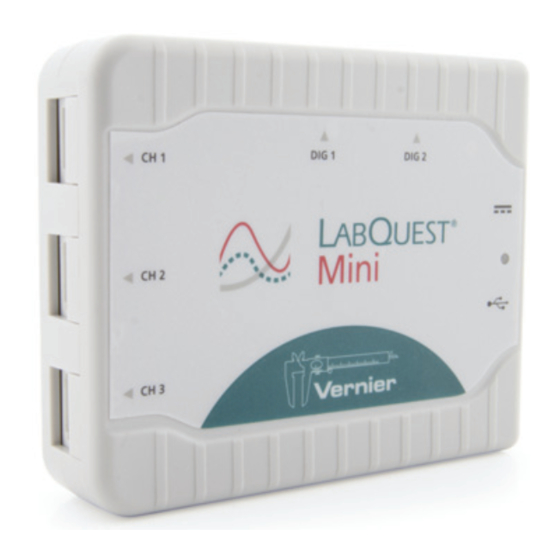
Advertisement
Quick Links
LabQuest Mini
(Order Code: LQ-MINI)
LabQuest Mini is a multi-channel, data-collection interface
that can be used to collect data from Vernier sensors on
various platforms, such as Windows
and Chromebooks™. LabQuest Mini supports a wired (USB)
connection only.
The LabQuest Mini interface contains three analog ports (CH 1–CH 3), two digital
ports (DIG 1 and DIG 2), a mini-USB connection, and a power adapter port
(although power through this port is rarely needed).
Note: Vernier products are designed for educational use. Our products are not
designed, nor are they recommended, for any industrial, medical, or commercial
process such as life support, patient diagnosis, control of a manufacturing
process, or industrial testing of any kind.
What's Included
LabQuest Mini interface
USB cable
Getting Started
Follow these general procedures when using LabQuest Mini. For instructions on
getting started with a specific sensor, see
1. Install software appropriate for the data-collection platform you are using.
2. Connect a supported sensor to LabQuest Mini.
3. Connect the small end of the USB cable to the USB port on LabQuest Mini.
4. Connect the other end of the cable to a USB port on your computer or
Chromebook. The LED will glow orange.
®
and Mac
®
computers
www.vernier.com/start/lq-mini
5. Start the software. The LED will change to green. You are now ready to
continue your experiment.
Compatible Platforms, Software, and Sensors
See
www.vernier.com/manuals/lq-mini
compatible with LabQuest Mini.
Providing Power
Power for LabQuest Mini is supplied by the USB port of the computer or
Chromebook to which it is connected. LabQuest Mini does not need batteries or
an external AC power supply.
Note: There may be configurations that limit how much power is available from
the USB port on a computer or Chromebook. Such configurations may include the
use of other devices that require USB power at the same time as LabQuest Mini. In
these situations, disconnect the other devices or use an external power supply
(order code LQ-PS) to provide additional power to LabQuest Mini.
Connecting Sensors
LabQuest Mini supports two types of sensors—analog and digital. Connect sensors
to the appropriate port on your LabQuest Mini.
Analog Sensors
Examples of analog sensors are temperature probes, pH sensors, and force sensors.
Up to three analog sensors can be connected to LabQuest Mini. The three ports for
analog sensors (CH 1–CH 3) are located on the left side of the unit. These ports
accept British Telecom-style plugs with a right-hand connector.
Digital Sensors
Examples of digital sensors include motion detectors, photogates, and
rotary motion sensors. Up to two digital sensors can be connected to LabQuest
Mini. The two ports for digital sensors (DIG 1 and DIG 2) are located on the top
for a list of platforms, software, and sensors
2
Advertisement

Summary of Contents for Vernier LabQuest Mini
-
Page 1: Providing Power
USB port on a computer or Chromebook. Such configurations may include the use of other devices that require USB power at the same time as LabQuest Mini. In these situations, disconnect the other devices or use an external power supply (order code LQ-PS) to provide additional power to LabQuest Mini. -
Page 2: Troubleshooting
The recycling of materials will help to conserve natural resources. Water Resistance LabQuest Mini is not water resistant and should never be immersed in water. If For more detailed information about recycling this product, contact your local city water gets in the device, immediately disconnect all sensors and cables. Allow the office or your disposal service. - Page 3 • www.vernier.com Rev. 6/1/16 LabQuest Mini and other marks shown are our trademarks or registered trademarks in the United States. All other marks not owned by us that appear herein are the property of their respective owners, who may or may...




Need help?
Do you have a question about the LabQuest Mini and is the answer not in the manual?
Questions and answers